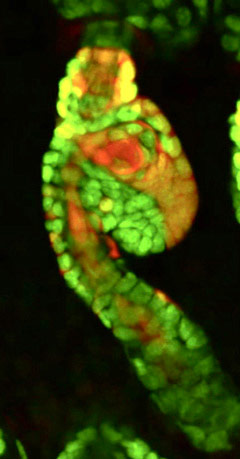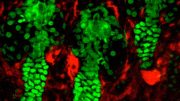
Photo of hair follicle stained to identify beta catenin mutations, which recruit neighboring cells to become hair follicles. Credit: Yale University
Researchers from the Yale School of Medicine have discovered a key link between tumors and healthy tissue, revealing a potential mechanism used by cancer cells to recruit healthy cells to promote tumor growth.
The delicate balance between the development of normal tissue and tumors depends in part upon a key molecular switch within cells, Yale School of Medicine researchers report in the March 21 issue of the journal Science. Their findings reveal a potential mechanism used by cancer cells to recruit healthy cells to promote tumor growth and suggest new strategies to generate healthy tissue.
“The fascinating result is that you do not need every cell to be mutated to create tumors, and that individual mutated cells can co-opt their neighbors to fuel tissue growth via this mechanism,’’ said Valentina Greco, assistant professor of genetics and of dermatology at the Yale Stem Cell Center, researcher for the Yale Cancer Center, and senior author of the study.
To understand how healthy cells can be transformed into growth-promoting cells, the Yale team of researchers led by Elizabeth Deschene and Peggy Myung induced new hair growth in mice by activating a mutant form of beta-catenin protein within hair follicle-producing stem cells. These cells recruited normal neighboring cells to become hair follicle cells by secreting a protein called Wnt, which promotes hair growth. Understanding this key interface brings researchers closer to safely leveraging the power of stem cells, which have the unique ability to create a variety of tissue types but are hijacked in many cancers.
“We now know, at the cellular level, how these cells recruit new growth,” Greco said. “We are excited to now use this information to investigate how to promote growth in a controlled manner to achieve normal tissue regeneration.”
Other Yale authors of the study are: Panteleimon Rompolas, Giovanni Zito, Thomas Yang Sun, and Ichiko Saotome.
The study was funded by the National Institutes of Health and the American Cancer Society.
Reference: “β-Catenin Activation Regulates Tissue Growth Non–Cell Autonomously in the Hair Stem Cell Niche” by Elizabeth R. Deschene, Peggy Myung, Panteleimon Rompolas, Giovanni Zito, Thomas Yang Sun, Makoto M. Taketo, Ichiko Saotome and Valentina Greco, 21 March 2014, Science.
DOI: 10.1126/science.1248373









It is a known fact, that only healthy cells are recruited in metastasis by cancerous cells, to alter their job of doing healthy ones. So much so, by this article, beta catenin of normal cells are doing the job of recruiting the neighboring cells to produce hair follicles, which is not otherwise their job. There is a plan hence for the ordinary cells to reverse back to their multipotent or pluripotent form. Just like stem cells differentiating into different form of functional cells, the reverse process also is possible. Hence there is a certain method surely, to reverse the cancerous cells back to their original form. Thank You.
cancer > mutation > evolution ?
Could you control this change to allow regrowth of dead cells by adding a actively dividing cell to dead cells and mutating the surrounding tissue to regrow the dead area like in stroke victims